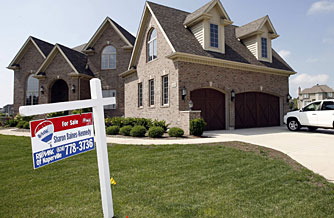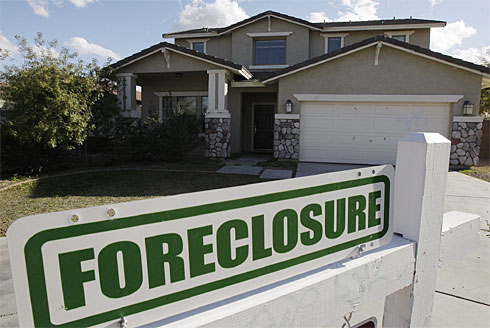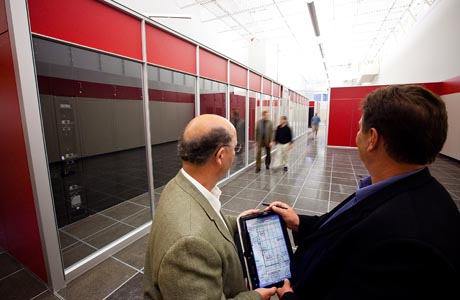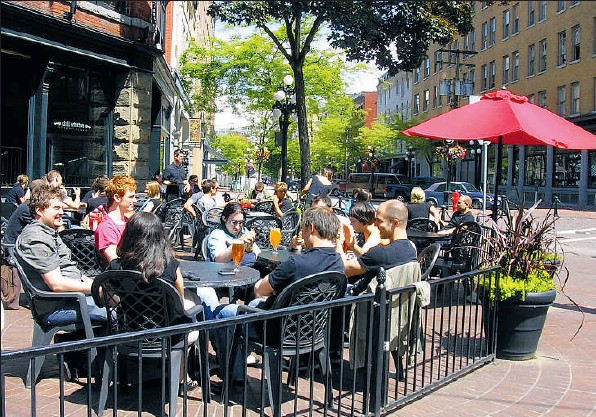Stephanie Armour
USA Today

Victor Montalvo-Lugo, right, with children Isaac Montalvo and Amanda Fischer at their future home, which is under construction in Urbana, Md., on July 3. They have yet to sell their California home. By Truth Leem, USA TODAY

A home sits for sale in Batavia, Illinois. More than four months after the Obama administration launched its housing rescue plan, scores of lenders are focused on rewriting loans. By Jeff Haynes, Reuters
More than four months after the Obama administration launched its housing rescue plan, scores of lenders are focused on rewriting mortgage loans to make them more affordable.
But one demographic is being largely ignored: homeowners with higher-price loans.
They don’t qualify for mortgage modifications under the Obama plan. They can’t get today’s low interest rates if they try to refinance. And with newly cautious lenders warier about who they lend to, just try to sell a home that costs $730,000 or more these days. In many cases, finding a buyer who can get financing takes far longer than for lower-price homes, because banks want as much as 30% down and six months of mortgage payments in reserve.
The result is a housing market in which sales and purchases of higher-price homes have come almost to a standstill, and it’s a predicament that could undermine the housing recovery. Move-up buyers (homeowners who want to buy larger, pricier homes) are getting locked out by lack of financing. Too many unsold homes in the top tier of the market also can push down prices for homes in the mid-price range.
“We need to have a market recovery in all segments,” says Lawrence Yun, chief economist with the National Association of Realtors (NAR). “If the high-end market weakens, those in the middle have to reduce prices.”
While the number of homeowners with higher loans is small relative to the entire market, Yun says, “All of Middle America is undoubtedly impacted.”
Jumbos and super-jumbos
Bigger loans, known as jumbo loans, come in three types.
Loans up to $417,000 are considered “conforming,” and can be sold to mortgage-finance giants Fannie Mae and Freddie Mac, which also guarantee them when they resell those mortgages to investors. But after that, the situation is more complex.
Loans between $417,000 and $729,750 are “conforming jumbo,” and loans above $729,750 are “super-jumbo.” Fannie and Freddie back only conforming jumbos, and what qualifies as conforming can vary depending on location. In San Francisco, Fannie and Freddie will back loans up to $729,750. In Atlantic City, the maximum is $453,750.
Lenders are leery of making loans above the amount that Freddie and Fannie will guarantee, because if a jumbo loan borrower defaults, it’s harder for a bank to quickly sell a higher-end foreclosed property. And because Freddie and Fannie don’t buy non-conforming jumbo loans, there’s less of a secondary market for super-size loans.
States with the highest percentages of jumbo mortgages include Hawaii, California and New York, as well as the District of Columbia. In New Jersey, Maryland, Massachusetts, Virginia, Connecticut, Washington, Nevada and Florida, jumbos account for 10% or more of all loans.
Jumbo loans aren’t just for the very rich: In some pricey areas, $500,000 may buy only a modest single-family house or condo.
Sales of higher-price homes have slowed to a glacial pace, driving the supply of homes for sale above $750,000 from 18.7 months in 2007 to 41.1 months in 2009, according to NAR.
With home values still falling in many areas, borrowers who took out jumbos a few years ago are finding they can’t refinance, and their mortgages are sliding into default. The number of jumbos 90 or more days delinquent reached 4.83% in March 2009, up from 1.68% in March 2008, says First American CoreLogic.
That trend is helping spread the foreclosure crisis from real-estate-bubble markets, such as California and Florida, where the housing crisis started, to other areas. Data from First American CoreLogic show that delinquency rates on jumbo mortgages under $1 million have more than doubled in areas such as Atlanta, St. Louis and Portland, Ore.
Some cities with high percentages of jumbo loans that are 90 or more days delinquent include Merced, Calif., Muncie, Ind., and Las Vegas-Paradise, Nev.
It’s been a costly situation for Victor Montalvo-Lugo, a clinical program manager at MedImmune in Gaithersburg, Md. He and his wife, Janette, bought a $1.6 million home in Thousand Oaks, Calif., in late 2005. He moved to Maryland for the MedImmune post in December, contracting for an $800,000 home to be built by late August. But with the California house on the market for weeks, he’s had no luck selling, even asking $1.05 million.
If he can’t sell that home before a company buy-out option expires, Montalvo-Lugo worries about the financing on the new one. A similar but smaller home down the block from his in California is listed in the $900,000s, forcing him to lower his initial asking price. “I’m very concerned. We are already listing for less than what we owe,” Montalvo-Lugo says. “We lost all of the initial equity, and we owe the bank more than we will get.”
Pressure on prices
Those with jumbo loans who lose a job or have an adjustable-rate mortgage that resets to a higher amount are struggling. But help is scarce: Under the Obama housing rescue plan, homeowners with loans above $729,750 aren’t eligible for mortgage modifications. Lenders may make such modifications on an individual basis, however.
Many homeowners in higher-end markets are finding they must drastically lower prices to try to get buyers. From July 1, 2008, to July 1, 2009, nearly 26% of homes on the market for more than $1 million have seen price reductions, and the average reduction is 13% off the asking price, according to real estate information provider Trulia. Homes on the market for less than $1 million have seen an average reduction of 9% off the asking price.
“What you’re seeing are those properties sitting on the market for a lot longer because people can’t get loans,” says David Kerr, a ZipRealty agent in the San Francisco area. “I got a call about a property in Berkeley for more than $1 million and almost fell out of my chair. All of what we’re showing is in the $200,000 to $300,000 price range.”
Jumbos are still being offered at Investors Savings Bank in Short Hills, N.J. But demand has slacked off because those taking out or refinancing jumbo loans must pay higher interest rates than other borrowers, says Richard Spengler, chief lending officer. Rates on jumbos are hovering around 6%, vs. 5.20% on a 30-year, fixed conventional loan.
The bank requires down payments of 20% to 30%, depending on the size of the jumbo. Spengler says many banks have gotten out of jumbo lending because of the lack of a secondary market. Investor Savings Bank keeps jumbos it issues in its own portfolio.
The overall stagnation in the market has a spillover effect on the economy. NAR estimates the slump in the jumbo home loan market has led to a $42 billion decline in economic activity.
That’s because borrowers who take out jumbos have much higher incomes than a typical borrower (an average $207,600 in 2007, says NAR’s most recent data) and when they buy a home, they spend a lot to furnish it. When sales of costly homes slow, sellers of furniture, carpeting, flooring and appliances get hurt.
Z Gallerie, a home merchandise retailer, is the latest in a string of higher-end stores to feel pinched. The store filed for bankruptcy-court protection from creditors in April, citing a severe sales drop. January sales were down 19% from a year earlier.
“The high-end retailers are being impacted,” says Gary Drenik at BIGresearch, a consumer intelligence firm. “When people buy a home, home-improvement and related sales go up.”
Those who can buy higher-end homes are seeing their discretionary income further whacked by strict lending conditions. Lenders are requiring some borrowers seeking to finance 80% of their home purchase keep 40% of the total loan value in a reserve account, says Michael Tooker, a mortgage planning specialist for Valley Private Mortgage Group in Scottsdale, Ariz. On a $1 million loan, “that’s $400,000 in reserve,” he says. “Some want six months total debt service in reserve. It’s so arbitrary.”
Camille Swanson, a Realtor at Realty Executives in Phoenix, can relate to the struggle. After selling her home, she fell in love with a foreclosed stacked-stone home in the desert that had been abandoned. But she discovered that no lender wanted to give her a jumbo loan on a property that needed so much renovation.
Swanson is almost finished obtaining a loan for the new place with an approval up to $640,000, but details are still being negotiated. With her 20% down payment, the total investment will be $800,000. She approached five lenders as far as Washington before finding one in her area to give her a loan. She didn’t need money in reserve because of her retirement assets. “For them, it’s an issue of risk,” Swanson says.
Raising the roof
Real estate groups such as the NAR are pressuring Congress and the Obama administration to increase the jumbo loan limits that Fannie and Freddie will guarantee and make them permanent. Current amounts were raised in 2008 and are set to expire Dec. 31. They also want the Federal Reserve to buy jumbo-backed securities because Freddie and Fannie can’t. The hope is that Fed purchases would create enough of a secondary market for these loans so banks would be more open to lending higher amounts.
Meanwhile, in jumbo-heavy markets, homeowners are increasingly frustrated by their inability to sell. They can’t relocate for jobs or retirement. They can’t unload vacation homes that they may now struggle to afford.
One such homeowner is Robert Westover, who works for the federal government in Washington, D.C. He’s been trying for months to sell a home in Hawaii with an ocean view. He bought it for $585,000 six years ago; it was valued at $1.1 million during the real estate peak in 2006. But there are no offers. He planned to list it for $940,000, but his Realtor suggested $890,000. Then he lowered it to $850,000. At one point, a potential buyer came forward but had no financing.
“It’s just been tough. It was getting crazy,” says Westover, 45, who now is taking the home off the market and renting it instead. “I hope I’ve learned a lesson, which is don’t put anything on the market in this economy. Most people who have homes in the jumbo (price range) are reliable, pay bills. Why are we suffering while the government gives help to everyone else?”










